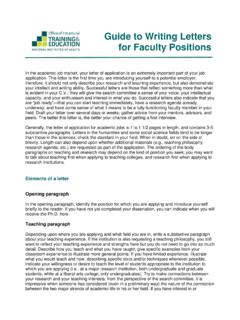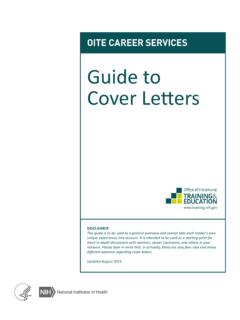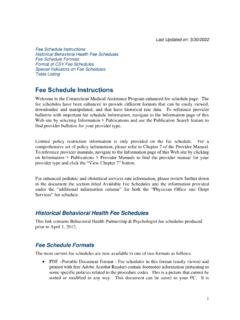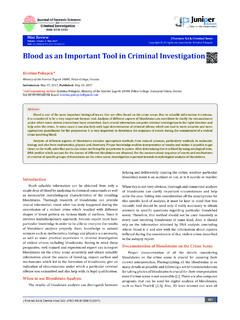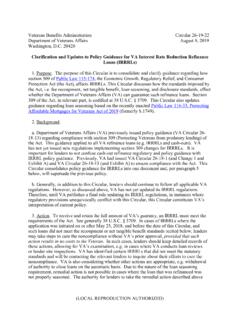Transcription of Keeping a Lab Notebook - National Institutes of Health
1 Slide 1 Keeping a Lab NotebookBasic Principles and Best PracticesPhilip Ryan, PhDScientific Program AnalystOffice of Intramural Training and Education Welcome to the National Institutes of Health , Office of Intramural Training and Education s Webinar on Keeping a Lab Notebook . This is intended to be a first step in understanding the basic principles and some of the best practices for Keeping a sound scientific Notebook . While these are widely considered to be the basics, the ultimate decision on what kind of lab Notebook , the format, and the content will be determined by the principal investigator for whom you work. Slide 2 Overview Introductory material What is a lab Notebook ? What are the different types of lab notebooks? Lab Notebook do s and don'ts Structure and organization Lab Notebook ethics Examples of good notebooks In this Webinar, we will define what a lab Notebook is both practically and philosophically. We will discuss the different types of notebooks and the advantages and disadvantages of each.
2 We will cover some of the basics do s and don ts in Keeping a lab Notebook including appropriate content for the Notebook , how much detail you should include, and some of the ethical considerations in Keeping a Notebook . Finally, we will show some examples of what a good lab Notebook looks like. Slide 3 A Lab Notebook Complete record of procedures, reagents, data, and thoughts to pass on to other researchers Explanation of why experiments were initiated, how they were performed, and the results Legal document to prove patents and defend your data against accusations of fraud Scientific legacy in the lab To get started, we need to understand what a lab Notebook is, what it is not, and why it is important to keep a good Notebook . A lab Notebook is a complete record of procedures (the actions you take), the reagents you use, the observations you make (these are the data), and the relevant thought processes that would enable another scientist to reproduce your observations.
3 This generally includes an explanation of why the experiments were done, including any necessary background and references, how the experiments were performed and the results of the experiments. It is important to understand that your lab Notebook is a legal document. In the case that your research contributes to the issuing of a patent, it will be closely scrutinized because it documents your group s claim to the discovery. Also, if any allegations of fraud are brought against your published work, your lab Notebook is used to validate your findings and defend your claims. Another way to view your Notebook is that it is your scientific legacy for that lab. Long after you have moved on from the lab, your Notebook will remain and be referenced. Others will be building on the research that you are doing now and it is imperative that they can replicate what you have done. A proper Notebook will allow those who come after you to do that. A poorly kept Notebook will not.
4 Ultimately, your lab Notebook is how you will be remembered during this time in your career. Slide 4 A Lab Notebook Is A journal A record of communications A place to compile lab protocols/manuals Yours to take home A common misunderstanding about a lab Notebook is that it is a journal for your scientific or personal musings. It is not. There is a difference between recording a hypothesis to be tested by a specific experiment and writing down ideas about how things might work. Thinking about the possible directions of your research and theorizing about how a system works is often how scientific breakthroughs are made. However, these thoughts and ideas should not be kept in your lab Notebook . Likewise, your lab Notebook is not where you should keep a record of conversations or communications you have with your boss or labmates. Your lab Notebook is also not the place to copy or store protocols from commercial product manuals. By documenting the company and product, you can reference the manual in your procedures.
5 Most importantly, your lab Notebook is not yours. It belongs to the institution for which you are working. You should not take it home for any reason. You do have the right to make photocopies of all your work and in many cases this is strongly encouraged. Slide 5 Different Types of Lab Notebooks Bound/Stitched Notebook Loose Leaf/Three Ring Binder Notebook Electronic Notebook There are three main types of lab notebooks: the bound or stitched Notebook , the loose leaf or three ring binder Notebook , and the computer based electronic Notebook . Each of these notebooks has advantages and disadvantages as well as having supporters and detractors. While you may be more comfortable with one type of Notebook over the others, ultimately, the type of lab Notebook you will keep will be decided by the principle investigator for whom you work. Slide 6 Advantages/DisadvantagesType of NotebookAdvantagesDisadvantagesBound/Sti tchedNo lost pages, legally strongerDifficult to copy, not logically organized, requires references to data stored elsewhereLoose Leaf/BinderOrganized by experiment, data stored togetherSheets fall out, difficult to authenticateComputer/ElectronicEasy to search, easy to read, digital data easy to storeRequires electronic security, corrupted files, software compatibility issues The bound or stitched Notebook is the traditional lab Notebook .
6 The pages are numbered and all bound together, which lowers the likelihood of losing pages. Since the numbered pages make it easy to see if any pages have been removed, the bound Notebook is still considered to be a legally strong Notebook that is trusted to protect against allegations of fraud. However, it is difficult to make copies of bound notebooks and you must record the things that you do in the order that they are done, which makes organizing your Notebook by experiment difficult. Also, since there is no way to insert bulky data records such as developed film, you must keep the data stored elsewhere and reference it in the Notebook . The loose leaf or three ring binder notebooks help address the last two disadvantages of the bound notebooks. Because you can enter sheets in any order, you can organize your Notebook by experiment and you can keep more of the data in one place. Three ring binders can also hold more bulky data adjacent to the written records to which they relate.
7 However, it increases the chances of losing sheets from your Notebook and provides the opportunity for sheet removal. Because of this, it is difficult to authenticate the data in the Notebook as not having been altered. Electronic notebooks are rapidly increasing in popularity because of their ease of use, legibility and ability to be easily searched. Also, if you can convert your data to a digital file, the electronic Notebook has a large capacity for storing data. However, having an electronic Notebook requires more advanced technological protections, and requires frequent system backups of the digital information . As is the case with all software, there are often compatibility issues as new versions of the software are released. Slide 7 What Goes in the Lab Notebook Notebook name Inside cover or cover page Your name and year General project name Lab mailing address Table of Contents Body of Notebook Experimental entries Now that we have an understanding of the different types of laboratory notebooks, we need to know the important components that all notebooks should contain.
8 Each Notebook should have a name that is on the cover. This allows for easy identification of the lab Notebook . Either on the inside cover or on a separate cover page, you should write your full name and the year you are starting the Notebook . Along with your name should be the name of the project associated with the lab Notebook , and the lab s mailing address with your principal investigator s name. At the front of each Notebook you should keep a running table of contents for ease in searching the Notebook and finding the necessary information . Finally, the lab Notebook will have multiple entries for your experiments. The contents of these entries will be discussed in a later slide. Slide 8 Writing the Laboratory Notebook , Kanare, ACS, 1985 Table of Contents Table of Contents Page number Date Subject/Experiment You see here an example of a table of contents from a lab Notebook . It is taken from the book, Writing the Laboratory Notebook by Howard Kanare.
9 While formats vary for Tables of Contents, the important information remains the same. The date the entry was made, the subject of that entry, and where in the lab Notebook that entry can be found. With this information , someone needing information from your lab Notebook can find it quickly. Slide 9 Experimental Entries Date Title Hypothesis or Goal: Brief statement of purpose Background How: Protocols, calculations, reagents, equipment Observations: All that happens (planned or unplanned) Raw experimental data Taped in information or reference to data location Data analysis: Processing of raw data, graphs, interpretations Ideas for future experiments Each entry should contain the date it was made, a title for the experiment and a hypothesis or goal for the experiment. Enough background should be included to explain the logic behind the experiment. This may include references to published literature or scientific talks, a short synopsis of your thought process, and references to previous experiments in the lab.
10 The entry should include either the written protocol that was followed or a reference to one previously used or published, all calculations performed, and a list of reagents and equipment used. In the next slide, we will go into more detail on what needs to be included in this How section. The heart of the experimental entry is the observations made. In short, this is where you record everything that happens during the experiment. This means any deviation from the protocol, whether it was planned, an accident, an error or a mistake needs to be written down. This is also where you record any raw data you collect, such as numerical readings from a piece of equipment or qualitative observations such as the reaction solution becoming cloudy or changing color. You never know what will be important once the data are analyzed, so write down everything. Also remember to tape in any data that you either print out or write on a separate piece of paper. If the data cannot be entered in the Notebook , be sure to include a reference to where it is stored.

